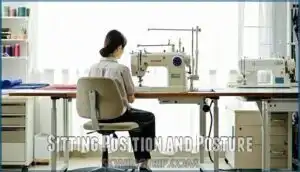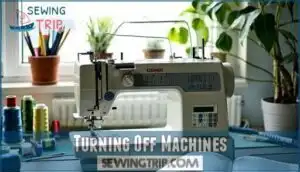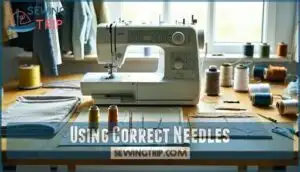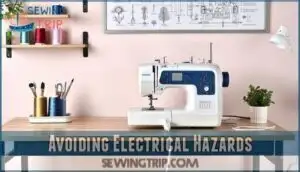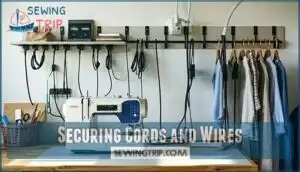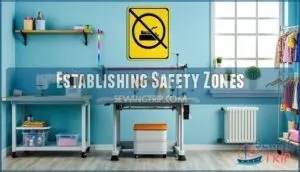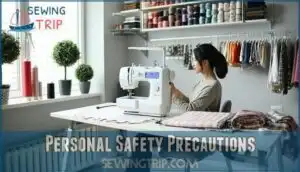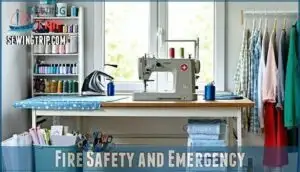This site is supported by our readers. We may earn a commission, at no cost to you, if you purchase through links.

Always turn off and unplug your sewing machine when you’re done, and fold up that ironing board before someone takes a tumble. Secure loose cords to prevent tripping, maintain good lighting to avoid eye strain, and keep a first aid kit within arm’s reach.
These simple sewing room safety ideas transform your creative space into a sanctuary where accidents don’t crash your crafting party. Smart organization and mindful habits reveal even more protection strategies, ensuring a safe and enjoyable creative space.
Table Of Contents
Key Takeaways
- Store sharp tools properly – Keep scissors, rotary cutters, and pins in locked containers or high shelves, away from curious hands and pets to prevent accidental cuts and injuries.
- Maintain electrical safety – Always unplug your sewing machine before needle changes or adjustments, secure loose cords to prevent tripping, and inspect equipment regularly for frayed wires.
- Create organized workspaces – Clear clutter from floors, establish safety zones around equipment, and position fire extinguishers within reach to prevent accidents and enable quick emergency response.
- Practice proper ergonomics – Maintain good posture while sewing, take regular breaks every 20-30 minutes, and keep your fingers at least one inch away from moving needles to prevent strain and injury.
Sewing Tool Safety
Your sewing tools are only as safe as how you handle them, and sharp tools actually protect you better than dull ones.
Sharp tools in skilled hands are your best defense against sewing room accidents.
You’ll prevent most accidents by storing scissors, rotary cutters, and pins properly and keeping them maintained for precise, controlled cuts.
Handling Sharp Tools
Every sewing enthusiast knows that sharp tools can turn from helpful allies into dangerous hazards in an instant.
Here’s how to handle them safely:
- Pass scissors handle-first to prevent accidental cuts during handoffs
- Cut away from your body when using rotary cutters and blades
- Never catch falling sharp objects – let them drop and pick up safely
- Keep fingers one inch away from moving needles during machine work
- Use fabric manipulators instead of fingers to guide material near blades
Proper handling and storage of sharp items is essential for maintaining a safe workspace, including adherence to sharp item safety guidelines.
Storing Sharp Tools
Store sharp tools in designated containers with secure lids, keeping scissors in blade guards and needles in wrist pincushions.
Use clear, labeled organizers so you’ll spot what you need without rummaging through a dangerous treasure hunt.
Lock away cutting tools if children or pets share your space—your rotary cutter isn’t a toy, and curious paws don’t understand sharp objects equal danger.
A well-organized sewing tool box is essential for maintaining a safe and efficient workspace.
Maintaining Tool Sharpness
Sharp tools work better and safer than dull ones. Regular Tool Sharpening and Blade Maintenance keep your equipment performing at its best.
Dull scissors tear fabric instead of cutting cleanly, while worn needles can damage delicate materials.
Here’s your sharp tool maintenance checklist:
- Scissor Care – Have fabric scissors professionally sharpened every 6-12 months
- Needle Honing – Replace sewing machine needles after 8-10 hours of use
- Cutter Safety – Change rotary cutter blades when they start skipping or pulling
- Regular inspection – Check all sharp objects weekly for nicks or damage
- Professional servicing – Schedule annual maintenance for electric sharpeners and complex tools
Preventing Accidents With Tools
Tool handling becomes second nature when you follow basic safety precautions.
Never leave sharp objects unattended on tables or floors—they’re accident magnets. Keep scissors and rotary cutters closed when not in use, and always cut away from your body.
Create a no-fingers zone around moving needles, maintaining at least one inch of distance. Remove pins before they reach the needle to prevent machine damage and potential injury.
Following proper needle safety guidelines is essential to minimizing risks while sewing, and it is crucial for minimizing risks.
Machine Operation Safety
Your sewing machine deserves the same respect you’d give any power tool—after all, it’s got a sharp needle moving at lightning speed just inches from your fingers.
Proper machine operation isn’t just about getting perfect stitches; it’s about keeping all ten digits intact while you create your masterpiece.
Sitting Position and Posture
Position yourself directly in front of your sewing machine with feet flat on the floor for ideal stability.
Choose ergonomic chairs with proper back support to prevent spine strain during long projects. Keep your machine at eye level to maintain natural sitting alignment and avoid hunching forward.
This setup reduces back tension substantially. Don’t forget occasional neck stretching between seams—your body will thank you later for prioritizing sewing room ergonomics and comfort.
Turning Off Machines
Beyond proper posture comes another fundamental aspect of sewing machine safety: powering down your equipment. Machine shutdown isn’t just about flipping a switch—it’s your first line of defense against accidents and electrical hazards.
Here are key power-down practices for sewing room safety precautions:
- Turn off before needle changes – This simple step prevents accidental starts during maintenance
- Unplug when adjusting presser feet – Complete electrical safety means zero power during equipment maintenance
- Switch off during breaks – Power savings and accident prevention go hand-in-hand
- Check electrical safety tips regularly – Inspect power cord safety for frayed wires or damage
Think of your sewing machine like a sleeping giant—respect its power even when it’s resting.
Using Correct Needles
Using the right needle for your project isn’t just about avoiding frustration—it’s about preventing dangerous needle breakage and ensuring your safety.
Needle selection depends on fabric types: ballpoint needles for knits, sharp needles for wovens, and heavy-duty needles for thick materials.
Match your thread choice to needle size for superior stitch quality.
Regular needle care and replacement prevent sudden breakage that could cause injury.
Avoiding Electrical Hazards
Electrical safety starts with proper cord management – keep power cords away from walkways and secure them behind machines.
Inspect electrical equipment regularly for frayed wires or damage, replacing faulty components immediately. Install surge protectors to shield your sewing machine from power surges.
Guarantee proper grounding systems and avoid daisy-chaining outlet extenders or power strips, which can overload circuits.
Proper machine maintenance involves checking for electrical safety to prevent accidents and guarantee longevity of your sewing machine, ensuring electrical safety is a top priority.
Workspace Organization
A well-organized sewing room isn’t just about aesthetics—it’s your first line of defense against accidents and injuries.
You’ll create a safer, more efficient workspace by eliminating clutter, securing loose cords, and establishing clear safety zones around your equipment, which will help you maintain a well-organized space.
Clearing Clutter and Tripping Hazards
A cluttered sewing room is like a minefield waiting to catch you off-guard.
Your sewing space becomes a danger zone when clutter takes over—clear paths save lives.
Keep your floors clear of fabric scraps, pattern pieces, and thread spools that love to migrate underfoot.
Store supplies in organized bins and drawers rather than leaving them scattered around.
Regular workspace cleanup prevents those heart-stopping moments when you’re carrying hot irons or sharp scissors, and remember: clutter control equals trip hazard prevention.
Securing Cords and Wires
Tangled electrical cords create dangerous tripping hazards throughout your sewing space.
Route cords along walls using cable management systems and secure them with cord organizers to prevent falls.
Install power strips with surge protection near your workspace, keeping voltage transformers off the floor.
Proper cord safety tips include using electrical securing methods like cable clips and wire organization solutions for maximum protection.
A well-planned workspace triangle is also essential for maintaining a safe and efficient sewing room, with proper cord safety being a key aspect.
Establishing Safety Zones
Smart sewing room safety zones create invisible barriers that protect you from harm.
Establish a no-fingers zone around your sewing machine needle—imagine drawing a circle where hands shouldn’t venture.
Use boundary markers like colorful tape to mark hazard areas near sharp objects and electrical equipment.
Post hazard signs above your cutting station and rotary cutter storage.
Keep emergency routes clear by positioning furniture strategically, ensuring you can quickly exit if needed.
These visual cues become second nature, transforming your space into a secure creative haven, with clear emergency routes, visible hazard signs, and a safe environment.
Maintaining Good Ventilation
Good air quality keeps your sewing room healthy and comfortable.
Open windows or use exhaust fans to remove fabric dust and lint that can irritate your lungs.
Install HEPA air purifiers for dust control and breathing safety.
Clean ventilation systems regularly to maintain fresh air circulation.
Poor sewing room ventilation causes coughing, eye irritation, and fatigue—nobody wants that interrupting their creative flow!
Effective air purification systems are essential for a healthy workspace, ensuring fresh air circulation.
Personal Safety Precautions
Your body takes a beating during long sewing sessions, so proper ergonomics aren’t just nice-to-have—they’re essential for preventing chronic pain and keeping you productive.
Smart habits like maintaining good posture, taking regular breaks, and using the right tools will help you sew comfortably for years to come, which is crucial for preventing chronic pain.
Maintaining Proper Posture
Sewing marathons can leave you feeling like a pretzel.
To keep posture in check, remember these posture tips:
- Choose ergonomic chairs with proper back support.
- Adjust sitting alignment so elbows, hips, and knees are at right angles.
Practice neck stretching often, and focus on hand positioning training to reduce strain.
Use sewing ergonomics to reduce back tension, and follow these guidelines to maintain a healthy sewing routine.
Taking Regular Breaks
Regular breaks aren’t just nice-to-haves—they’re your secret weapon against sewing room injuries.
Set a timer for every 20-30 minutes to remind yourself to pause. Stand up, roll your shoulders, and give your eyes a rest from close work.
Even a quick 2-minute stretch can prevent muscle tension and improve focus. Your mental health benefits too, as breaks help reset your concentration and reduce stress from detailed projects.
Avoiding Fatigue and Distractions
Avoiding exhaustion and distractions while sewing isn’t just about comfort—it’s about preventing accidents that happen when your Mental Focus wavers.
Eye Care becomes essential during detailed work, and proper Task Prioritization helps maintain concentration throughout your project.
- Schedule break frequency every 45-60 minutes to refresh your mind and prevent eye strain from close work
- Create a distraction-free zone by silencing phones and closing doors to maintain steady concentration
- Practice the 20-20-20 rule by looking at something 20 feet away for 20 seconds every 20 minutes
- Use Time Management techniques like breaking large projects into smaller, manageable segments
- Monitor your posture and energy levels throughout sessions to catch fatigue before it compromises safety
Remember: a tired seamstress is an accident waiting to happen.
Break Strategies and regular breaks aren’t luxuries—they’re essential Break Strategies for maintaining both sewing enjoyment and workshop safety.
Using Ergonomic Tools
Your hands deserve better than cramped, aching sessions that leave you questioning your hobby choice.
Ergonomic tools transform your sewing experience with spring-loaded shears, padded handles, and wrist support that work with your body’s natural movement.
Smart finger guards protect digits while maintaining dexterity, and proper tool grip reduces strain during extended cutting sessions.
These investments in hand protection and ergonomic handles aren’t luxury items—they’re essential partners in maintaining healthy posture and preventing repetitive strain injuries in your organized sewing sanctuary.
To avoid electrical hazards, remember to unplug before adjustments.
This simple precaution is crucial for ensuring a safe sewing environment and preventing accidents that could jeopardize your sewing experience.
Fire Safety and Emergency
Fire safety isn’t just about having the right equipment—it’s about creating habits that prevent disasters before they start.
You’ll want to keep flammable materials like fabric scraps and paper patterns well away from your iron and heating tools, while ensuring you have both a fire extinguisher and first aid kit within easy reach of your sewing space.
Preventing Fires With Flammable Materials
Fire can turn your creative sanctuary into a disaster zone faster than you can say "thread count."
Smart fire prevention measures start with proper material storage and heat control. Here’s your emergency planning checklist:
- Store fabric scraps and paper patterns away from heat sources – no piles near irons or lights
- Keep flammable materials in metal bins to contain potential ignition
- Maintain good ventilation to prevent combustible dust buildup
- Clean regularly – lint and fiber accumulation creates fire hazards
- Use flame-resistant treatments on fabrics when possible for added protection
Using Fire Extinguishers
Keep a fire extinguisher in your sewing room and know how to use it before you need it.
Position it near your exit but away from potential fire sources like irons and electrical equipment.
Understanding fire extinguisher types and basic emergency procedures can save your space and maybe your life.
Regular maintenance also involves checking for machine safety precautions to prevent accidents.
| Fire Extinguisher Types | Best For | Location Tips |
|---|---|---|
| Class A | Fabric, paper, wood | Near cutting table |
| Class C | Electrical fires | By main electrical panel |
| Class ABC | Multi-purpose use | Primary sewing area |
| Class K | Grease/oil fires | Near heat press station |
Having First Aid Kits
A well-stocked first aid kit transforms your sewing sanctuary into a prepared workspace.
Stock yours with bandages, antiseptic wipes, scissors, and pain relievers—your Kit Essentials for quick Accident Response.
Position Emergency Supplies within arm’s reach, not buried in closets.
Master First Aid Basics like cleaning cuts and applying pressure to wounds. Smart Wound Care prevents minor mishaps from becoming major headaches.
Establishing Emergency Procedures
Beyond having first aid supplies ready, you need a solid emergency plan that everyone in your household knows by heart. Think of it as your safety roadmap when things go sideways.
- Post evacuation routes near your sewing room door and practice them regularly
- Designate a meeting spot outside your home where family members can gather
- Keep emergency contacts visible, including fire department and poison control numbers
- Assign roles during emergencies – who calls 911, who helps others evacuate
- Review your plan monthly to guarantee everyone stays sharp on procedures
Frequently Asked Questions (FAQs)
Are you safe in the sewing room?
You’re absolutely drowning in potential hazards.
But with proper precautions, you’ll transform your sewing space into a sanctuary.
Keep sharp tools stored safely, maintain good posture, unplug machines during maintenance, and organize your workspace to prevent accidents, which will help you achieve a safe and efficient working environment with proper precautions.
How to create a safe sewing room?
Organize your space with designated storage for sharp tools, maintain proper lighting and ventilation, keep electrical cords secured, and always unplug machines when not in use.
What are some sewing safety tips?
Keep your fingers away from moving needles, unplug machines before adjustments, store sharp tools securely, maintain good posture, and take breaks to prevent fatigue and accidents.
How do you keep a sewing room safe?
Store sharp tools in designated containers, maintain proper posture while sewing, unplug machines when changing needles, keep workspaces clutter-free, make certain of good lighting, and position fire extinguishers within reach.
How do I make sewing safe?
Use sharp tools properly, maintain good posture, unplug machines during adjustments, organize your workspace, take breaks, and keep fingers away from needles.
How do I keep my sewing machine safe?
Like a guardian protecting precious treasure, treat your sewing machine with respect.
Unplug it before needle changes, keep fingers away from moving parts, and maintain proper posture while operating it steadily.
What are some safety rules in a textiles room?
Always unplug machines before needle changes or adjustments.
Keep sharp tools in designated containers, maintain proper posture, and guarantee good lighting.
Store flammable materials away from heat sources for fire safety.
Can you give 5 safety precautions in sewing?
Keep your fingers clear of the needle while sewing, unplug machines before maintenance, store sharp tools safely, maintain proper posture, and never leave hot irons unattended.
How do we avoid accidents when sewing?
Sharp scissors and steady hands stay safe—maintain proper posture, unplug machines during adjustments, store tools securely, keep fingers away from needles, and take breaks to prevent fatigue.
What are the safety equipment for sewing?
You’ll need sharp scissors, rotary cutters with safety guards, pin cushions, thimbles, and seam rippers.
Don’t forget proper lighting, ergonomic chairs, fire extinguishers, and secure storage containers for keeping tools organized and accidents at bay, which includes having secure storage.
Conclusion
Your sewing sanctuary deserves more than just beautiful fabrics and perfect stitches—it needs a foundation of safety that protects your passion.
By implementing these sewing room safety ideas, you’ll create a space where creativity flows freely without the shadow of accidents.
Remember, a well-organized workspace isn’t just about aesthetics; it’s about preserving your ability to craft for years to come, which is a key aspect of a sewing room safety plan.
Your future self will thank you for establishing these protective habits today.
- https://www.lendingtree.com/insurance/appliance-injuries-study/
- https://sew4home.com/sewing-room-safety-needles-and-pins-and-blades-oh-my/
- https://wunderlabel.com/en-gb/blog/p/14-essential-sewing-safety-tips-beginners/
- https://wayne.osu.edu/sites/wayne/files/imce/Safety%20rules.pdf
- https://konsew.com/blog/staying-safe-in-the-sewing-room

